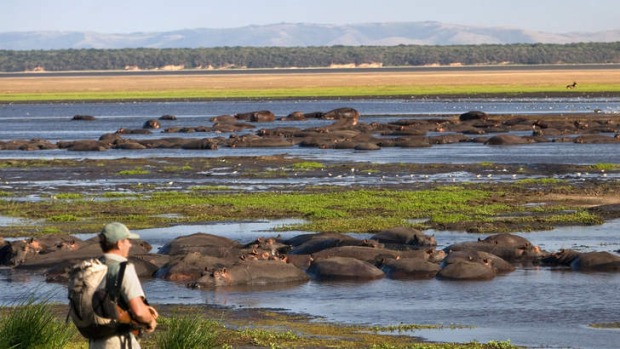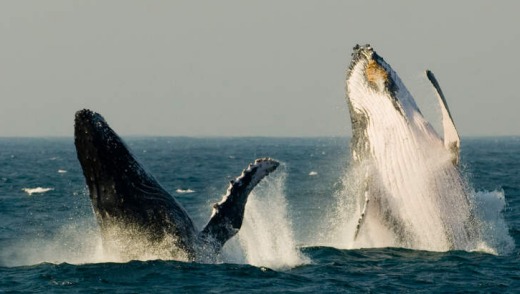
Andrew Bain comes face-to-face with locals in and around St Lucia.
The laid-back South African town of St Lucia is very much a settlement on the wildlife frontier. Great white sharks and migrating humpback whales cruise along its shores, leatherback and loggerhead turtles nest along its beaches, rhinoceroses and leopards graze and hunt in the surrounding iSimangaliso Wetland Park, and crocodiles and hippopotamuses float about like croutons in the estuary that wraps around the town.
Even the town's streets are inhabited by wildlife. In the evenings it's not unusual to see hippos wandering along St Lucia's main drag, and in 2012 a resident lost a leg after he was attacked by a hippo in his garden.

"My parents have seen a leopard walking through the streets," says my guide, Ian. "They say there are six leopards living in the town."
It sounds as though I could just sit in a bar and watch wildlife parade past, but I'm driving with Ian through iSimangaliso, the vast World Heritage-listed reserve that stretches along the coast from St Lucia to the Mozambican border, more than 200 kilometres to the north. It's a park of immense diversity, ranging from coral reefs to savannah and the world's second-highest coastal dune system, after Queensland's Fraser Island.
The drive to Cape Vidal, at the end of the road from St Lucia, which is on South Africa's east coast, 600 kilometres from Johannesburg, is a slideshow of wildlife. In the grasslands beside the road, there are antelopes, zebras are being tailed by wildebeest, and a white rhino calf skitters about beside its mother.
Hippos bubble up from lagoons, and dung beetles buzz past the open vehicle.
Slowly the bush thickens as we drive, until we reach Cape Vidal, where wind-brushed sand dunes ascend into forest. In the car park, vervet monkeys scurry about the cars. On the beach, swimmers splash in a calm, reef-protected corner, while elsewhere anglers cast lines into the fierce surf.
Further out, sometimes only 50 or 100 metres offshore, sprays of water reveal lines of humpback whales heading south, returning to Antarctic waters after calving in the ocean off Mozambique.
Less than an hour before, I was watching zebras and rhinos in the dry savannah. Now, I'm sitting in sand dunes, looking at humpback whales and pondering a swim. The thought strikes me that if you could distil greater South Africa into a single image - wildlife, beaches, space, the vague thrill of danger - this area would probably be it.
The next morning adds another layer to the St Lucia experience. The estuary that enfolds the town is the largest in Africa, fed by about six rivers, and is the region's centrepiece, noted for its prolific hippo and crocodile populations.
Boat trips head through the estuary from the town's pier, and at dawn I'm sitting on a Heritage Tours and Safaris boat.
Even as we idle at the pier, a pair of eyes and nostrils materialise from the water a few metres from the boat. Plumes of mud rise behind the hippo as it steps along the shallow riverbed.
As we motor upstream and the morning warms, crocodiles begin to appear, either sunning on the banks or gliding past the boat in an archipelago of ridges and bumps.
The estuary is said to be home to 1000 crocodiles and 1500 hippos, but they are not the only dangers. Two species of shark, including the aggressive Zambezi or bull shark, also inhabit the waters.
"So going in the water is a very bad idea," chuckles our skipper, Lawrence, and I pull my hands further inside the boat.
An hour upstream, Lawrence noses the boat into the estuary's eastern bank and we wander out into iSimangaliso's curious kind of savannah. Date palms sprout from the grasslands, and the soil forms one of the world's oldest peatlands, about 45,000 years old.
Buffaloes and waterbucks, known as the toilet seat antelope for the white circle of fur around their rear, roam just metres from where we walk.
Back in the boat, Lawrence idles across to a pod of hippos. Across the water are about 20 snorting and snuffling hippos rafted together as they rest. Only their noses, backs and ever-watchful eyes protrude from the water.
"We've been doing these trips for 15 years and, even two to three years ago, the bull hippo would charge the boat," Lawrence says. "It took that long to get them used to us. This is the closest you'll ever get to wild hippos."
After what I've heard about the literal wildlife in St Lucia at night, it's as close as I want to get.
TRIP NOTES
GETTING THERE
St Lucia is about 230 kilometres north of Durban. South African Airways has a fare to Durban from about $1600 return from Sydney and Melbourne including taxes. From Sydney, flights go direct to Johannesburg (14 hours, 15 minutes), connecting to Durban (1hr, 10min), while Melbourne flights connect through Perth and Johannesburg (11hr, 30min). See flysaa.com.au. North Coast Runner operates a door-to-door bus service from Durban Airport to St Lucia. See northcoastrunner.co.za.
TOURING THERE
Exodus Travels has a 15-day South African Walking Safari trip that includes time in St Lucia and iSimangaliso Wetland Park. Trips begin at $2885. See exodus.co.uk.
MORE INFORMATION
southafrica.net.
FIVE OTHER WILDLIFE EXPERIENCES BY THE SEA
HERMANUS
From June to December, this Western Cape town is considered the world's best shore-based whale-watching location.
GANSBAAI
Pluck up the courage to climb into a cage and dive among great whites.
SARDINE RUN
Through June and early July, snorkel above millions of sardines along South Africa's east coast.
STONY POINT PENGUIN COLONY
Less than 100 kilometres from Cape Town, this is one of only three mainland-based African penguin colonies in the country.
DE HOOP NATURE RESERVE
This coastal park is best known as a calving area for southern right whales. Walk the five-day whale trail for the full experience.